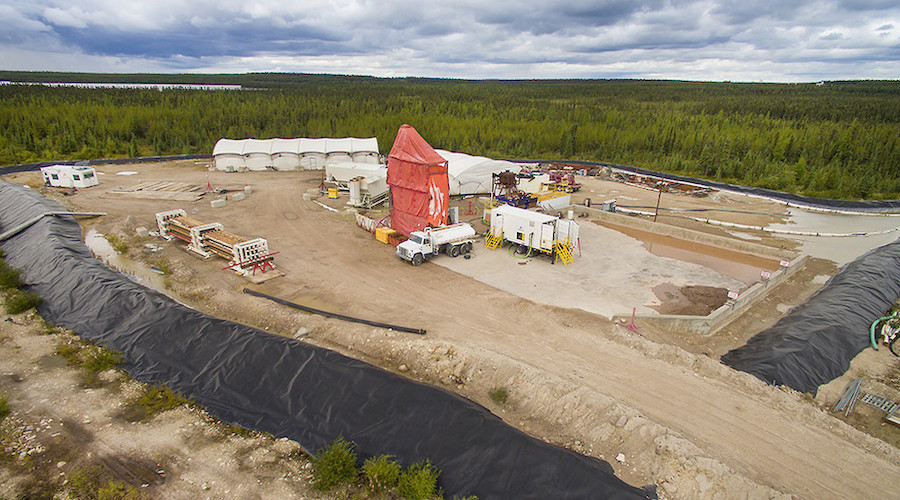Cecilia Jamasmie | January 24, 2024 |

The McClean Lake operations are in the eastern part of the Athabasca Basin, in northern Saskatchewan. (Image courtesy of Denison Mines.)
Denison Mines (TSX: DML) (NYSE: DNN) and joint venture partner Orano Canada said on Wednesday they will restart the McClean Lake mine, located in the uranium-rich Athabasca Basin in northern Saskatchewan, amid improving project and commodity economics.

Operations at McClean Lake, owned by the namesake JV (MLJV) in which Orano is the operator and has a 77.5% stake, were suspended in 2008 in response to weak uranium prices.
The partners continued to explore the licence and invested in proprietary mining method named SABRE, which is designed to selectively extract high-grade uranium ores from surface.
Mining is planned to restart at the McClean North deposit in 2025, with a target of about 800,000 pounds of uranium that year, the partners said. Activities this year focused on readying the site and equipment for continuous commercial operations, they noted.
MLJV will also install eight pilot holes for the first mining cavities planned for excavation.
“The successful mining test of the SABRE method in 2021 provided the MLJV with important information about the productivity and cost of the operation,” Denison’s president and chief executive David Cates said.
“This information suggests an incentive price meaningfully lower than current uranium prices, which has provided the JV with a strong basis to make a restart decision for mining,” Cates added.
The companies noted they have identified the availability of around 3 million pounds of yellow cake for potential additional production from a combination of the McClean North and Caribou deposits during the 2026-2030 period.
BMO Capital Markets uranium analyst Alexander Pearce said in a note on Wednesday the decision to restart McClean Lake was positive for Denison as it could help with modest near-term cash flow as it develops Wheeler River.
“The announcement also demonstrates that current spot prices are supportive of brownfield restarts,” he said, adding that a sizable near-term supply deficit is still expected considering the time it takes to bring restarts on.
Orano Canada’s President and chief executive, Jim Corman, said the JV’s current ability to capitalize on the strengthening uranium and nuclear markets is the result of a long-term investment in research and development to secure continued activities at McClean Lake.
The property, about 750 km north of Saskatoon, consists of four mineral leases covering an area of 1,147 hectares and 13 mineral claims over an area of 3,111 hectares.
Uranium prices have hit their highest in more than 16 years in recent days after the world’s largest miner of the nuclear fuel, Kazakhstan’s Kazatomprom (LON: KAP), highlighted production risks. The commodity’s bonanza is likely to continue prompting the restart of mothballed capacity.
Sprott is bullish on uranium as governments shift to the energy source
, BNN Bloomberg
Sprott Asset Management is increasingly bullish on uranium, as governments shift back to the metal as a clean energy source.
Sprott has two uranium trusts and a pair of uranium exchange-traded funds (ETFs) available for investors, as the commodity-focused investment firm works to convince investors there’s value in the once-ignored metal.
“We’ve obviously been very active in terms of educating the market about this investment,” John Ciampaglia, chief executive officer at Sprott Asset Management, told BNN Bloomberg in a television interview on Tuesday.
Ciampaglia said his company has remained exposed to the metal as governments looked at other energy options, but now that the focus is back on uranium, there is growth potential.
“Utilities are reloading their inventories of uranium after essentially drawing them down for the greater part of 10 years,” he said.
“This is really in response to the world shifting back to nuclear energy after largely ignoring it for the last 10 years. You expect a supply response to come from the market when the commodity price goes up 80 or 90 per cent and we are starting to see one clearly.”
Canada is the second largest producer of uranium in the world behind Kazakhstan, according to Natural Resources Canada, and the metal has been a focus for governments and experts looking at ways to increase green energy reserves.
No comments:
Post a Comment